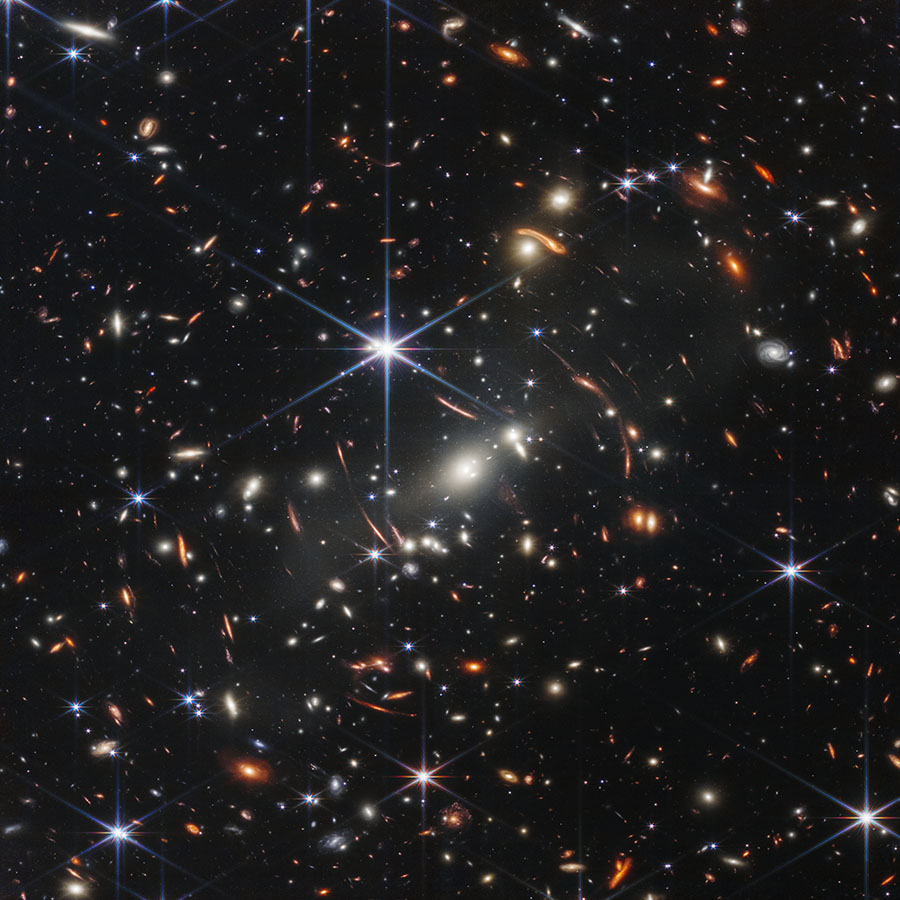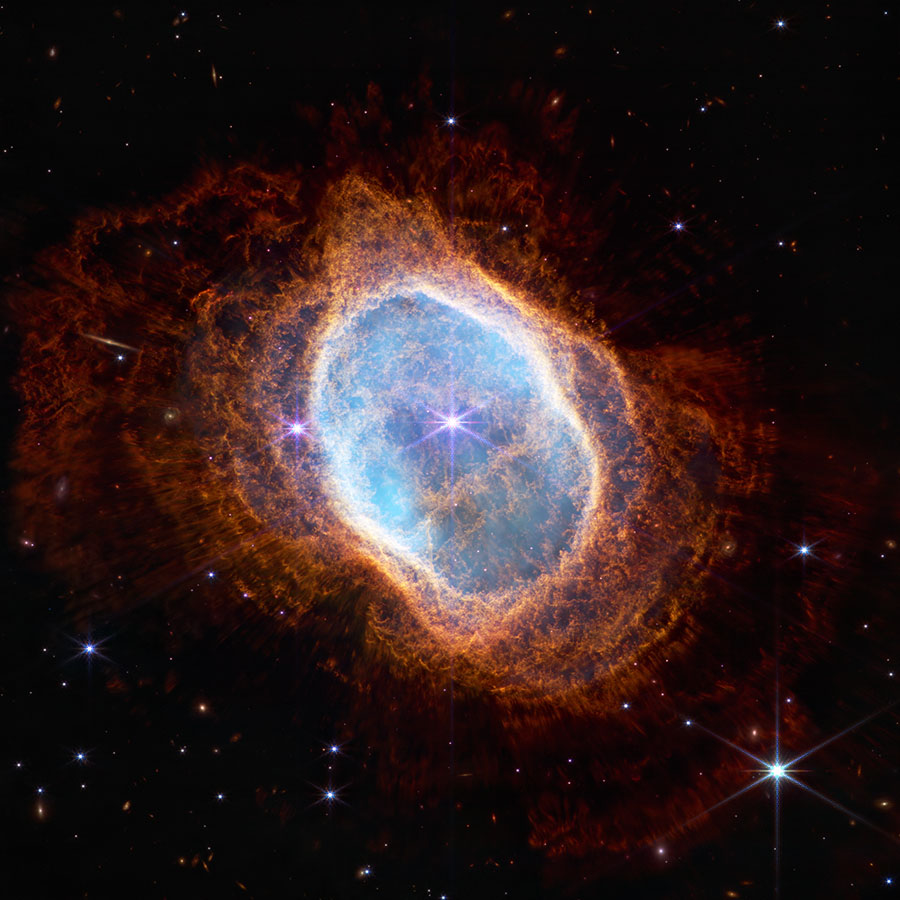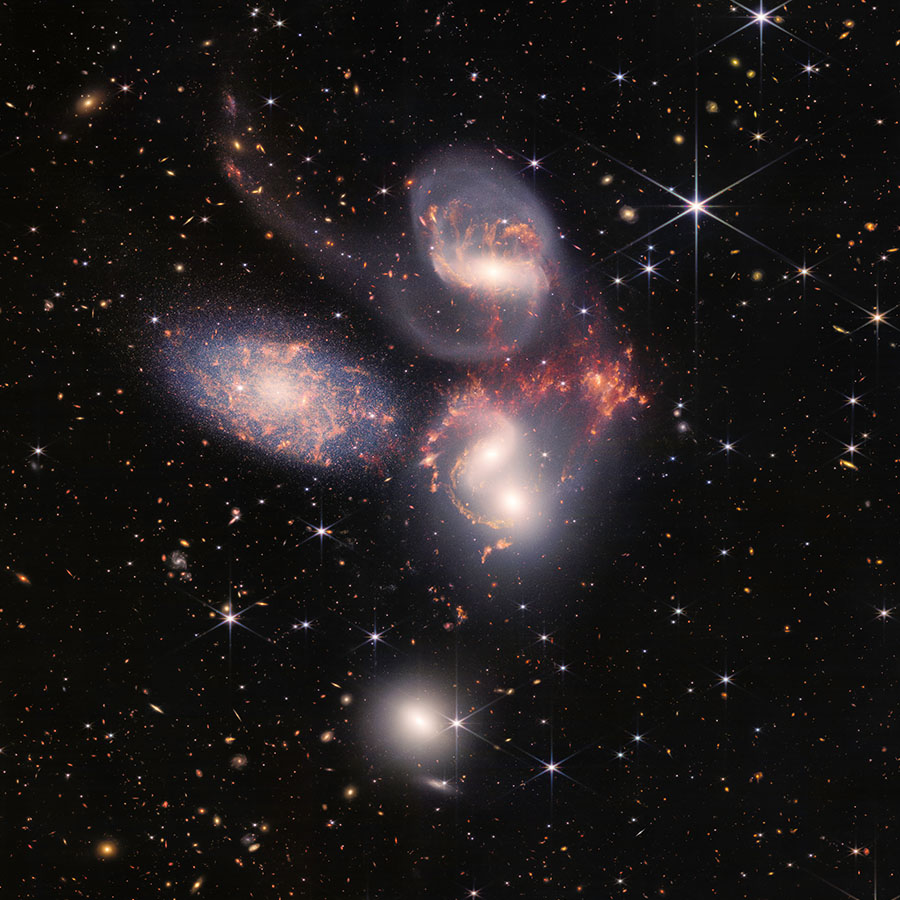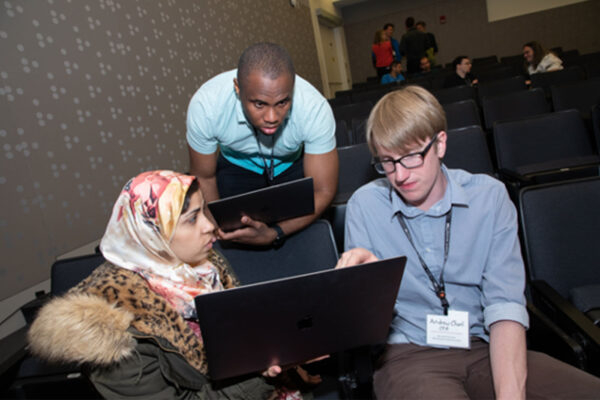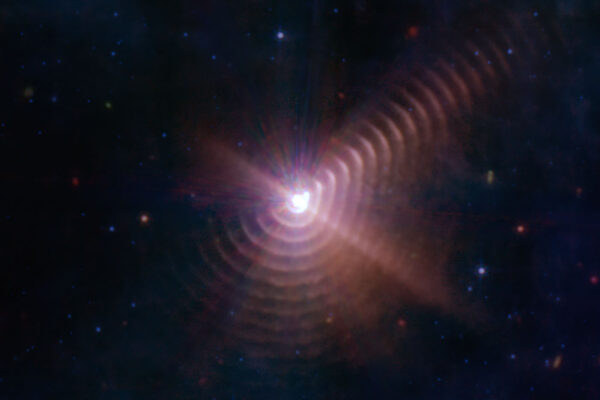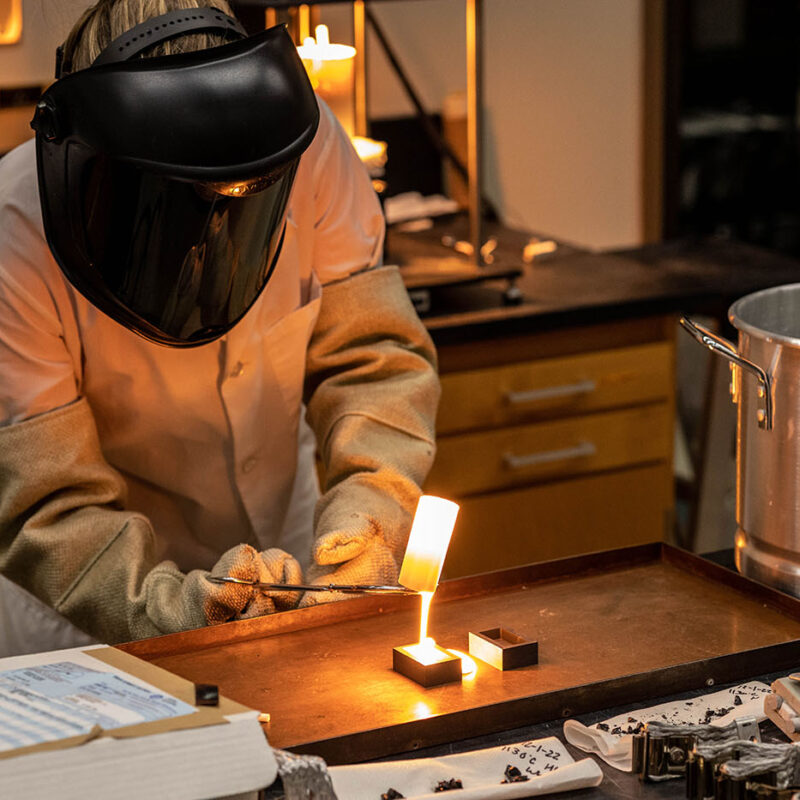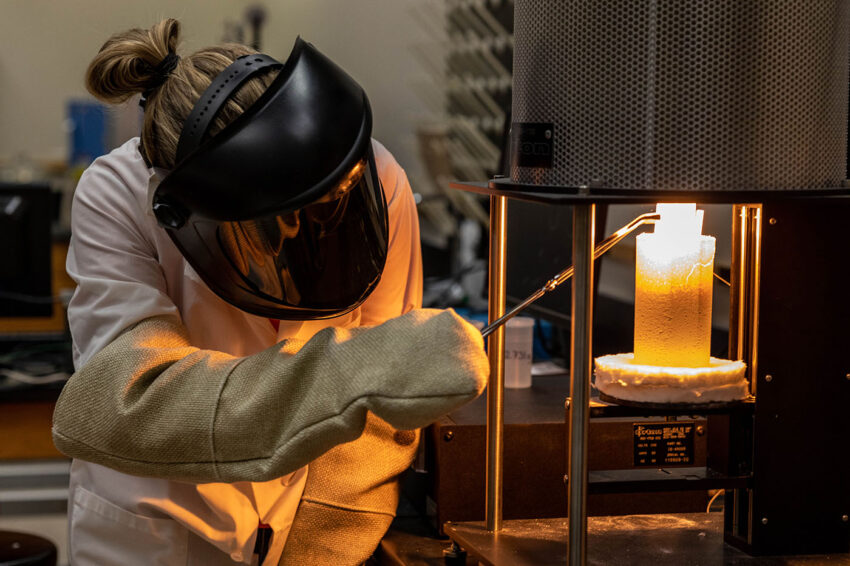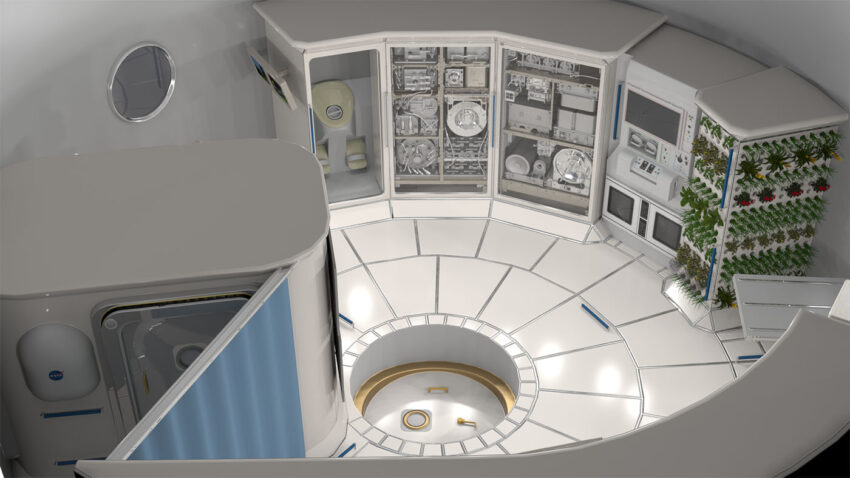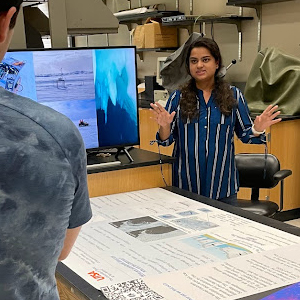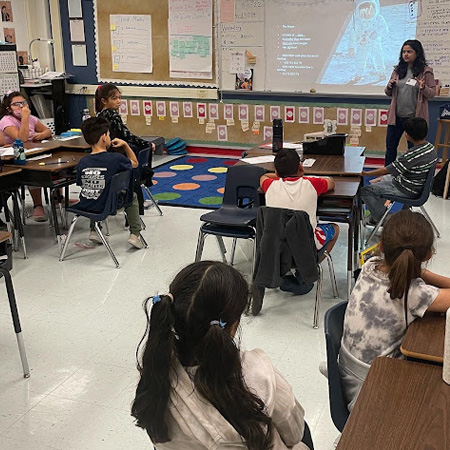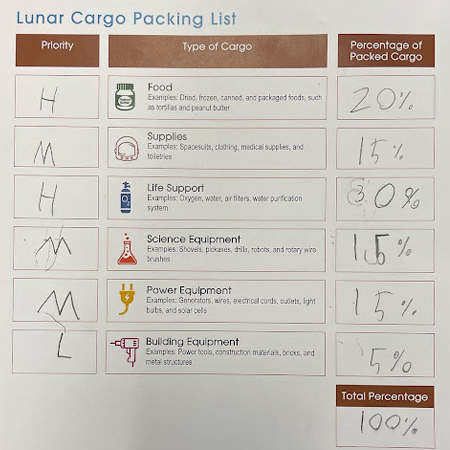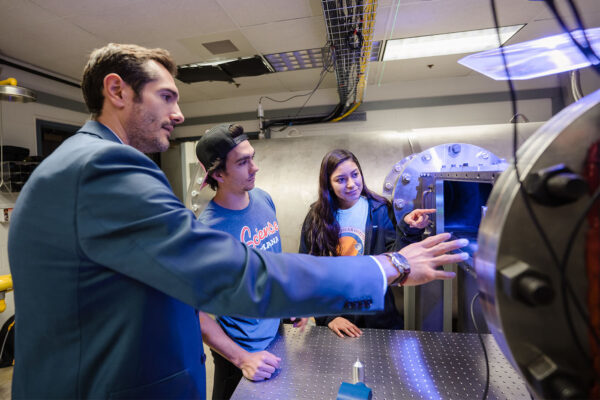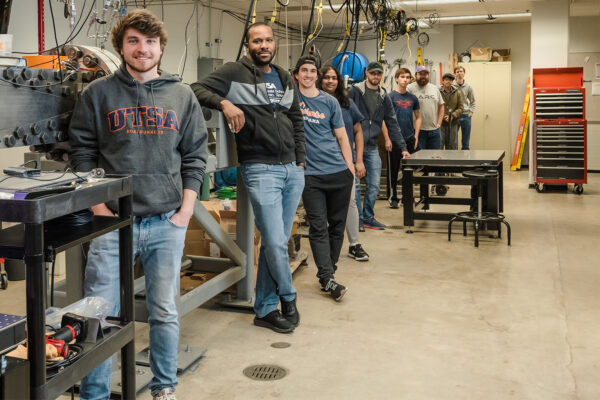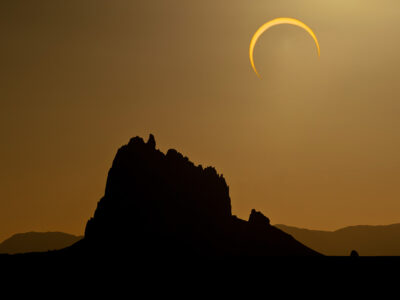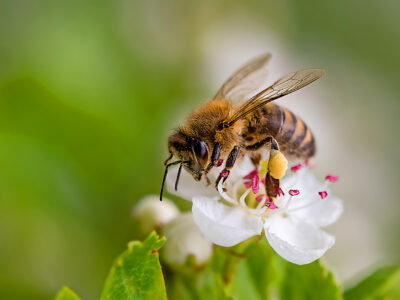The world is currently embracing space exploration with a fervor not seen since the Space Race of the 1960s. Findings from the James Webb Space (JWST) and Event Horizon telescopes have wowed the public at the same time that dozens of commercial players have made serious investments in space development. Life beyond Earth is becoming more approachable and research advances are bringing galaxies far, far away closer than ever.
UTSA has played a significant part in those breakthroughs. From black holes and stardust to lunar colonies and smart habitats, scientists and engineers at UTSA are gaining momentum in international efforts to answer questions we’ve been wondering about our galaxy and the broader universe for generations. Meanwhile, students across the university are gaining the hands-on science and engineering experience they need to pursue much-needed careers in the fields of space and aeronautics research.
Many of these Roadrunners briefly took their heads out of the stars to share their brilliant stories with Sombrilla Magazine.
MIND-BLOWING DISCOVERIES
The endless universe surrounds us, but mankind has long known very little about it. That’s starting to change thanks to recent international discoveries that have fundamentally altered our understanding of galaxies, black holes, stardust and much more. Innovative research at UTSA has been vital to these major breakthroughs and will continue to be essential for many years to come.
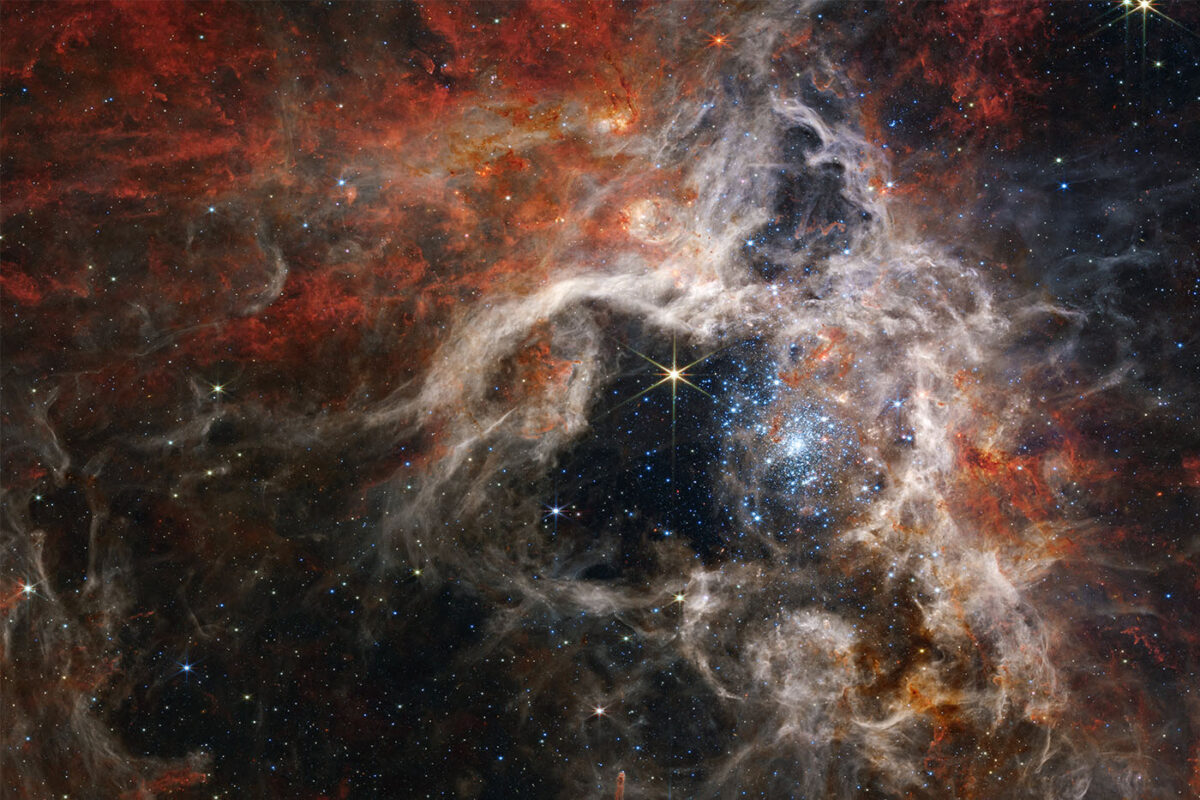
Exploring the Creation of Galaxies
Scientists across several departments at UTSA affectionately refer to the JWST as the “Just Wonderful Space Telescope,” and it’s easy to see why. From the Carina and Southern Ring nebulas to Stephan’s Quintet, the reveal of the telescope’s first images could only be described as breathtaking — even for seasoned astronomers.
“I knew that there would be much deeper images and much better-quality images. Intellectually, I knew that. But nothing prepared me for actually seeing the beauty of these images — both from an artistic point of view, but also a scientific point of view,” says Dr. Chris Packham, a professor in the UTSA Department of Physics and Astronomy.
The JWST operates with advanced infrared capabilities and boasts a 21-foot gold-plated beryllium mirror that allows it to capture more light than the Hubble Space Telescope. Astronomers use data from both instruments to assemble deeper and sharper images than ever before. Perhaps no image was more mind-blowing than the deep-field photo of SMACS 0723, a cluster teeming with thousands of galaxies, which are each in themselves a collection of roughly 100 billion stars.
“If you put a grain of salt or a grain of sand on the tip of your finger and held it at arm’s length, that would be how much sky is covered in this single image,” Packham explains. “There’s no such thing as blank sky anymore. There’s always a galaxy there. It’s just a total game-changer in how we do astronomy.”
Packham is co-leading an international team known as Galactic Activity, Torus and Outflow Survey (GATOS), which is implementing the JWST to study interactions between several black holes and their host galaxies at different life stages to learn more about how galaxies are formed.
In a similar vein, UTSA astrophysics professor Dr. Thayne Currie is using JWST data to learn more about the compositions of various exoplanets, which are planets outside of solar systems that orbit another star. Going forward, Currie hopes to use the JWST to reveal images of exoplanets more like those in our solar system and potentially habitable worlds.
“The direct-imaging capabilities of the Webb Telescope may be even more powerful than we anticipated, allowing us to study planets at wavelengths where it is difficult to image them from the ground,” Currie says.
Both professors say the JWST could keep them and other UTSA researchers busy for the next two decades or so. The telescope’s exploration of supermassive black holes, distant stars and unique planets around the universe, in particular, could fundamentally change science forever.
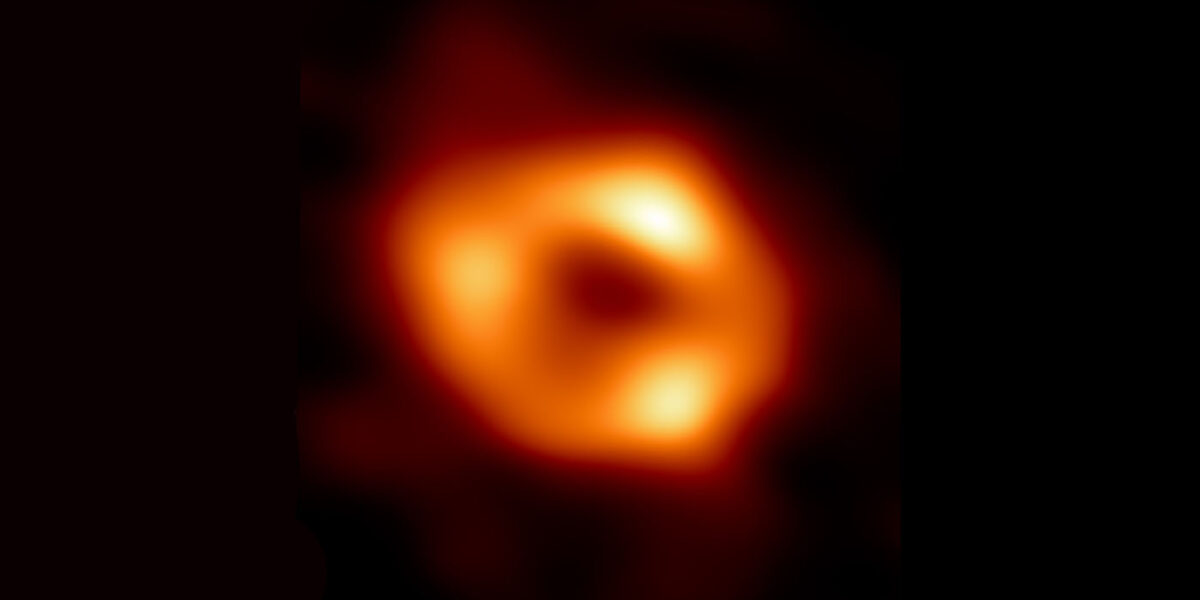
Shining Light on Black Holes
In May of 2022, a picture of the monstrous black hole at the center of our galaxy was captured for the very first time, and UTSA physics professor Dr. Richard Anantua was part of the international team that made it happen. Anantua is a member of the Event Horizon Telescope (EHT) Collaboration, a worldwide research collective that interpreted the groundbreaking image of the black hole known as Sagittarius A*. It was only the second time in history a black hole image had been produced.
“Imagine how an astronomy textbook would have evolved over time. For hundreds of years, there are figures of stars, planets and moons, and there are pretty pictures of Saturn’s rings,” Anantua says. “But for the first time, now, we can have pictures of black holes in our astronomy textbooks.”
Anantua’s models of the plasma physics flowing around Sagittarius A* helped make the image possible. Black holes are a source of gravity so strong that not even light can escape, which makes them impossible to see by any conventional measure, but they do discharge super-heated, swirling masses of plasma that form a ring around the black hole’s center.
Take a look at the image of Sagittarius A* and you’ll see the rings have glowing chunks in different places. These chunks are where the plasma is hottest — and that’s where Anantua’s research interest lies. His turbulent heating models were more successful than the thousands of others submitted around the world in providing explanations for the plasma heating detected around Sagittarius A*.
Black holes have been known to consume planets like a football team visiting a buffet, but Anantua says we need not worry about Sagittarius A*. It’s still a distant 26,000 light years away, and luckily for our solar system, it has a comparably low appetite.
“It might eat one sun’s worth of mass every 100,000 years even though it’s 4 million times the mass of our Sun,” he says. “So, that’s quite an extreme diet.”
Building from his contributions to the remarkable image, Anantua is now in the midst of launching the state’s first Event Horizon Telescope group at UTSA. He and a team of graduate students will focus on creating more types of simulations to decipher what’s swirling around black holes and exploring how certain events alter a black hole’s diet.
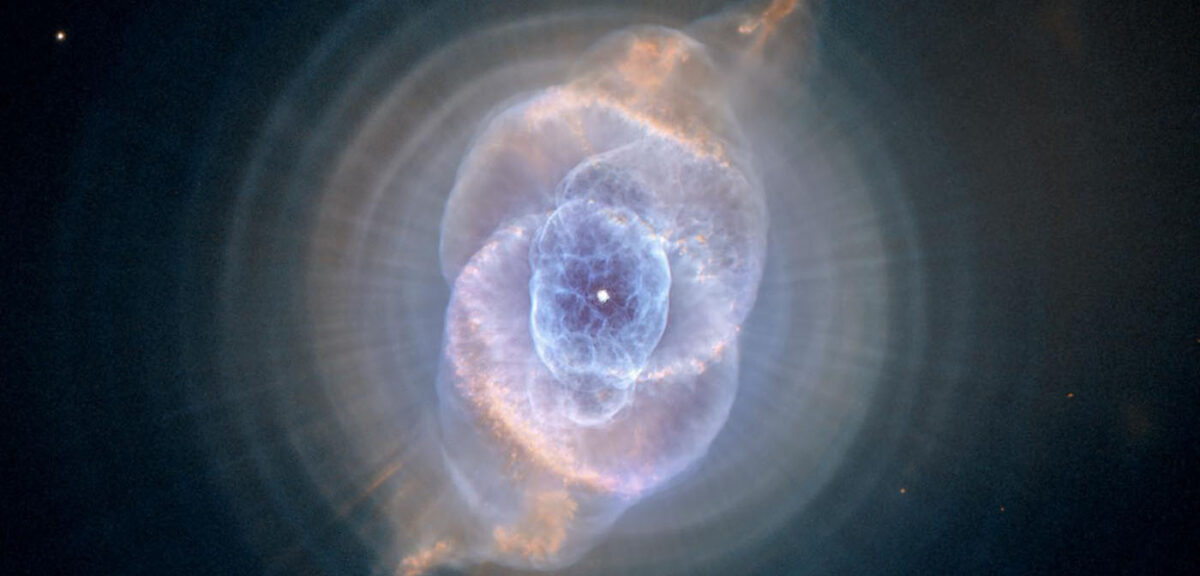
Demystifying Stardust
For hundreds of years, stardust was just the stuff that got in the way of astronomers hoping to catch a glimpse at planets, distant galaxies and black holes. But one UTSA researcher is showing everyone just how essential that dust has been to the history of the universe—and how it could be essential to Earth’s survival in the future.
Dr. Angela Speck, professor of astronomy and chair of the UTSA Department of Physics and Astronomy, is one of the world’s leading stardust researchers. Speck was recognized by the American Association for the Advancement of Science in 2022 for her contributions to our understanding of the effects of stardust across the cosmos. She has also earned funding from NASA and the National Science Foundation to uncover the mysteries behind this material ejected by dying stars.
“Now we’re seeing that it’s really important to understand dust because it affects everything,” Speck says. After all, she adds, each and every living being is essentially composed of the elements of stardust. “The first generation of stars only contained hydrogen and helium and nothing else. Why? Because everything else was born inside stars.”
UTSA is a member of the Association of Universities for Research in Astronomy (AURA), a select group of institutions that operate world-class observatories on behalf of NASA and the National Science Foundation. AURA’s Space Telescope Science Institute is responsible for the science missions for the Hubble Space Telescope and the JWST—both of which are used for important astronomy research at UTSA and around the world. UTSA provost Dr. Kimberly Andrews Espy has served on AURA’s board of directors for six years, while Speck and Packham serve as representatives.
The study of stardust sits in a unique pocket of astronomy that intersects with material science, geology and chemistry. Speck examines the naturally occurring space substance from a distance through infrared astronomy, then analyzes its molecular composition, mineral qualities and how the dust shells morphed over time. The impurities of the dust grains are fundamental to understanding how and when galaxies were forged.
“Depending on what a particular dust is made of — and by that, I mean everything that’s in it — that will tell us how quickly certain stars formed,” Speck says.
More than anything, Speck’s stardust research focuses on how the material interacts with light, and that could have huge ramifications here on Earth as the planet’s temperature continues to creep up due to climate change. Speck is doing foundational research into using stardust to cool the planet. Greenhouse gases in the atmosphere absorb infrared radiation and cause temperatures to rise, but if a small amount of stardust were shot into the stratosphere, it could reflect just enough sunlight to give Earth a few degrees of much-needed relief.
Speck admits that much more data will be needed about the long-term effects such a plan would have on visible light and the ozone layer. It would be years, or possibly generations, before it’s implemented. “It’s not something I’ll see in my lifetime, but we’re laying the groundwork,” she says. “We’re going so far beyond classic astronomy.”
MOON LIFE
It’s no longer just some pipedream from “The Jetsons.” Colonization of the Moon, and even Mars, appears to be inevitable. And while getting there is one thing, living there is another. Creating a sustainable society on the Moon or Mars presents tremendous challenges, but UTSA is leading the charge to come up with solutions. Collaborating, building, repairing — we’ve got it covered.
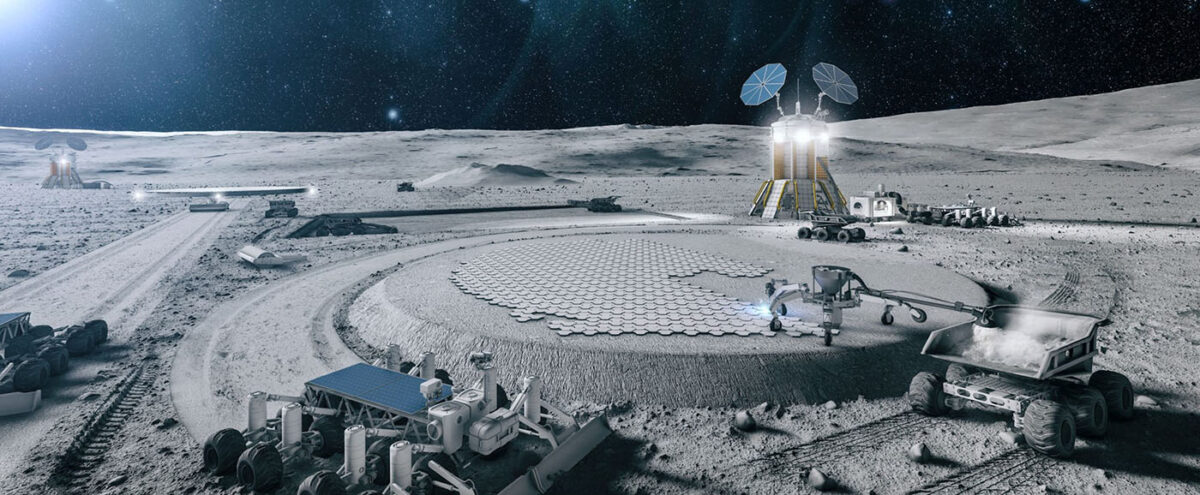
Building on the Moon
A sheepish grin comes over the face of Dr. Alan Whittington from his lab at UTSA’s Multidisciplinary Studies Building. “What we do here is really unusual,” admits the professor who specializes in planetary geology. “There aren’t many labs in the U.S. that apply the equipment we have to the things that we do.”
But doctoral student Brenna Halverson doesn’t think it’s unusual at all. “I get to make moon lava,” she says. “Come on. How is that not awesome?”
Whittington and his team have studied moon rock melting points, viscosity and other properties for the last two years to further a NASA-funded joint venture with San Antonio’s Astroport Space Technologies aiming to build launch pads and other structures on Earth’s Moon.
Transporting physical building materials to the Moon would be massively expensive, so Astroport and UTSA are contributing to an alternative: Melting moon soil (better known as regolith) to create building bricks. The process requires an instrument called an induction furnace-nozzle and a 3D printer to form and place lunar regolith bricks, but before that can happen, Whittington has been identifying the temperatures in which moon soil liquifies and examining the strength of the hardened product.
It’s a challenging task because each lunar simulant recipe leads to a different result. The surface of the Moon is comprised largely of basalt, but the far side of the moon is comprised primarily of feldspar. Meteorite impacts on the Moon have kicked up all this stuff, so Whittington’s team melts various mixtures of these minerals to see what works best and what doesn’t work at all.
“It’s sort of like the Colonel’s 11 different herbs and spices. Each one has their own little flavor,” he jokes while sorting through a drawer full of lunar simulant bags and containers. “The feldspar comes from different places, the basalt comes from different places, and some of them mix in another mineral like titanium.”
The researchers heat each simulant for 20 minutes in the lab’s furnace at temperatures sometimes exceeding 3,000 degrees Fahrenheit until it’s completely molten. The sample glows a brilliant orange as it’s poured before solidifying into a black glass. Their continuing aim is to identify the right convergence of factors that will result in solid bricks that can be large enough to be useful for building, won’t crack upon cooling, and can withstand extremely hot rocket blasts.
UTSA civil engineers Dr. Sazzad Bin-Shafique and Dr. Ibukun Awolusi are also working on the next step. They recently began developing transportation technologies that would deliver excavated regolith to Astroport’s Lunatron bricklayer system.
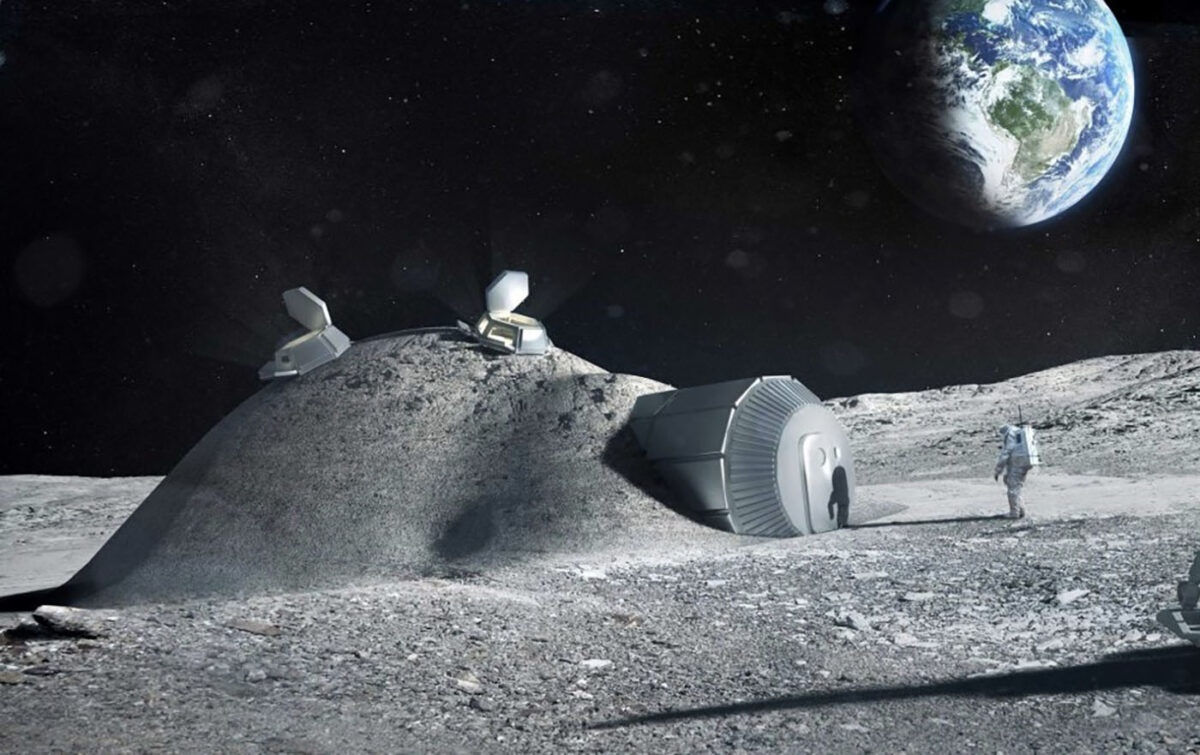
Strengthening Space Habitats
If you’ve ever watched “Gravity” or “The Martian,” you know that there’s an ever-present fear to existing in outer space: extreme events. In a matter of seconds, dust storms, quakes, meteorites or a plethora of other threats can cause structural or engineering damage that presents a life-threatening circumstance.
“You can’t call up a repair company or go to Home Depot in space,” says Dr. Arturo Montoya, an associate professor who holds a dual appointment in the Departments of Mechanical Engineering and Civil and Environmental Engineering.
To prevent issues from becoming emergencies, researchers at UTSA, Purdue University, Harvard University and the University of Connecticut are developing smart, survivable space habitats as part of a five-year, $15 million NASA study. Montoya is leading UTSA’s efforts in what is formally known as the Resilient Extra-Terrestrial Habitats (RETH) Institute.
In addition to serving as the senior program manager of research and development at the Southwest Research Institute, Dr. Kurt Retherford is an adjunct faculty member in the UTSA-SwRI Space Physics Graduate Program. Retherford was the principal investigator for a research team that recently found volatile chemicals and compounds frozen in ice on the Moon’s South Pole were very likely delivered through a comet impact.
UTSA’s Arturo Montoya is helping develop resilient space habitats like the one depicted in this Reth Institute rendering.
“The focus of our team is to create a resilient framework for the design of space habitats. And the key word there is resilient,” Montoya says. “Things will go wrong, so for the structure to be resilient, we need to figure out everything that can go wrong. We need to be ready to respond in a short amount of time because time is critical up there.”
Montoya and his students are developing flexible computer models that can recreate extreme space conditions for cyber-physical testing. These unique modeling platforms will provide fertile ground for the smart habitat’s network of sensors, which will actively learn, detect and swiftly diagnose issues. From there, the resilient habitats will incorporate autonomous robots that can either operate independently or collaborate with human users to make repairs and address other issues.
Montoya often discusses the RETH Institute’s efforts with students in the Margie and Bill Klesse College of Engineering and Integrated Design because it proves that a vast cross-section of engineers will be needed to tackle the challenges of the future. The smart habitats they’re developing need architects, civil engineers and construction managers to create habitat structures, interior designers to foster cozy internal environments, chemical engineers for preserved foods, biomedical engineers for medical devices, electrical engineers for power, computer engineers for communication with Earth and mechanical engineers for air pressure and thermal systems.
“You have to develop the techniques we have in place for Earth structures, but think outside the box due to the harsh environment in deep space,” he says.
THE GREAT SPACE WORKFORCE
Space exploration and habitation are tremendously big endeavors that are already requiring a tremendously large workforce. Through unique research endeavors, UTSA is giving its science and engineering students the skills and real-world experience they need to not only fulfill significant needs in the aerospace industry but also thrive in those positions.
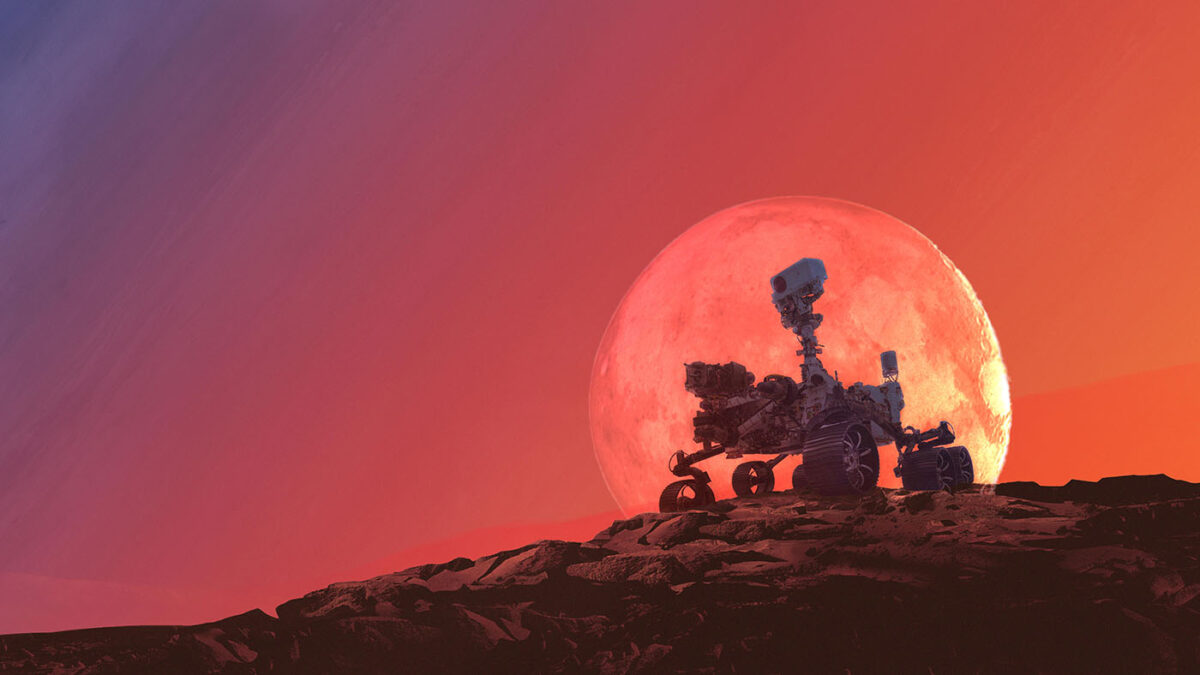
Weathering Planetary Extremes
Habitats aren’t all that need to be prepared for dust storms, solar irradiance and the various extremes of outer space. People do, too. The NASA MIRO Center for Advanced Measurements in Extreme Environments at UTSA — or CAMEE, for short — is dedicated to just that.
Working with big data recorded by rovers, taking oceanic and volcanic measurements, and crafting high-fidelity turbulence models, CAMEE faculty and students explore the extraterrestrial environments of the Moon and Mars alongside extreme climate events on Earth that can translate to space research.
An artificial Martian landscape lines the rotunda floor of the CAMEE offices. Here, students test out the 3D-printed rovers they’ve designed to see how they’ll traverse the rocky, red surface. One team, for instance, is trying out rover wheels fitted with a series of rollers that can make precise stops and work the vehicle out of jams. Another interdisciplinary team of students even dreamt up a rover with crustacean-like qualities for a NASA proposal in 2021.
UTSA received an initial $3 million from NASA in 2019 to develop CAMEE. The center trains a diverse group of undergraduate and graduate students to become highly-skilled professionals in STEM disciplines that support NASA’s mission, from measurements to modeling to data fusion. In fact, four CAMEE students have served as NASA interns this year, gaining hands-on experience with Mars rovers, jet propulsion, vegetation and aerodynamics.
Doctoral student Mansi Joshi was one of them, earning the Future Investigators in NASA Earth and Space Science and Technology Fellowship. Growing up, Joshi says she was always intrigued by space science and satellites. UTSA has given her the opportunity to live out that fascination. Her current research uses various types of satellite data to learn more about sea ice and the impacts of climate change.
“It has surely boosted my confidence,” Joshi says of earning the highly competitive NASA fellowship. “I hope to use it to go for summer schools and attend different conferences in my field to build connections and hopefully learn the art of collaborative research.”
CAMEE recently received a $2 million renewal grant from NASA, which will support a new laboratory where students will be able to incorporate virtual reality modules and additional 3D-printed robotics into their projects. CAMEE also aspires to add a vacuum tunnel for drone testing in addition to a small-scale replica Moon habitat with a domed structure on the UTSA campus.
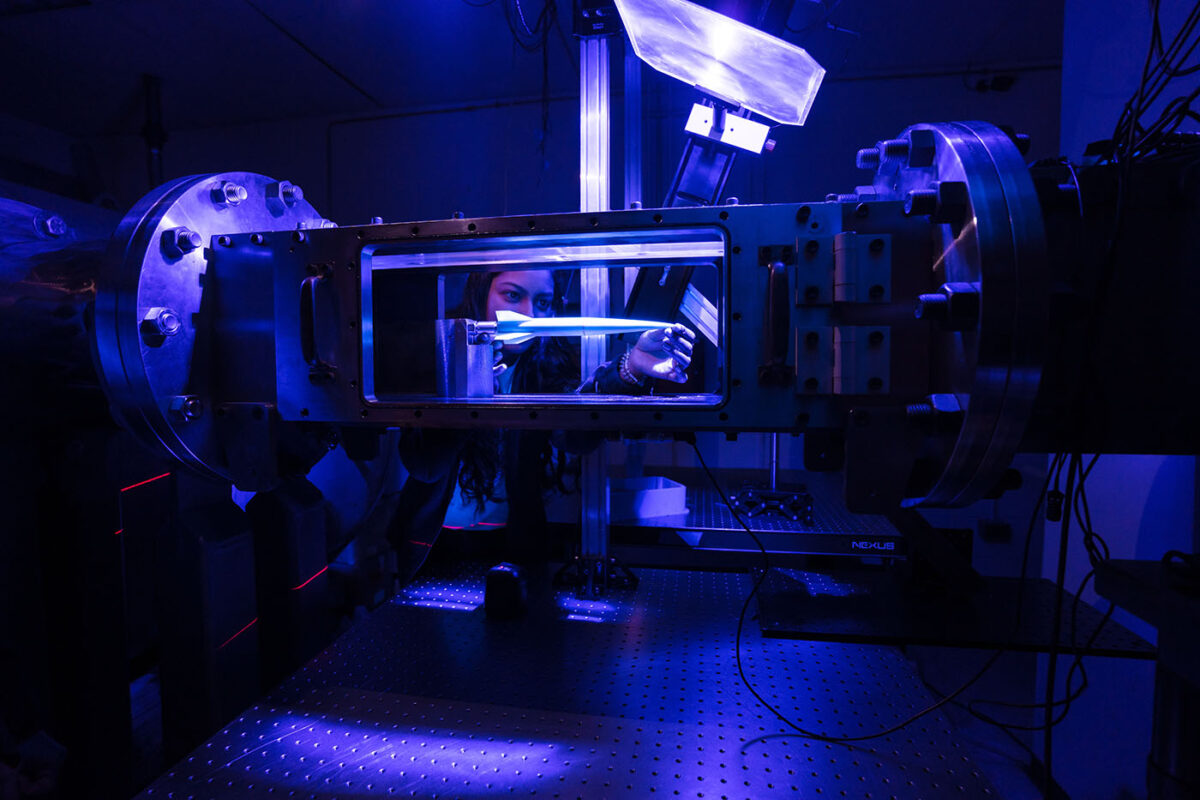
Surviving Space Flight
Chat with Dr. Chris Combs about the aerospace industry, and he’ll quickly tell you about how the Lone Star State leads the way. “Every major manufacturer is here,” says the Dee Howard Endowed Assistant Professor in Aerodynamics at UTSA. “We’re a central hub for all sorts of aerospace work, there’s a major defense presence, and all of these different space companies have popped up in Texas — SpaceX, Blue Origin, Firefly, you name it.”
More than 90 aerospace job listings popped up in San Antonio alone during the last year, but until fall 2022, there was no aerospace program in the city. That’s changed now that Klesse College has launched the M.S. degree in aerospace engineering at UTSA. Students in the program are working directly with Combs in the UTSA Hypersonics Lab, which features a 60-foot Mach 7 Ludwieg Tube Wind Tunnel, one of only five facilities at an American university capable of testing objects in flight at Mach 7 speeds. Unlike many of its peers, UTSA’s facility is also capable of free-flight testing.
“We can measure things like lift, drag, pressure and temperature on the object’s surface to help understand how vehicles are going to behave at that kind of speed,” Combs explains. “You get 20 milliseconds or so of this thing flying, so you get a lot of really powerful data out of it before it ends up in our vacuum tank at the end of the test.”
One high-profile space drone will be on the mind of Dr. Xinting Yu, an assistant professor in the Department of Physics and Astronomy who started at UTSA in January, for many years to come. She’s studying atmospheric and surface material properties on Titan, the largest of Saturn’s moons and the only moon in our solar system that boasts an atmosphere. Titan’s atmosphere is made mostly of nitrogen, like Earth’s, with a hint of methane. Yu seeks to learn more about this mysterious source of methane in the lead-up to NASA’s Dragonfly rotorcraft drone landing on Titan in 2034.
Twenty milliseconds may not seem like a lot of time, but high-speed acquisition cameras capture the footage at 2 million frames per second, logging thousands of images that usually result in a 15-minute video that can be studied. UTSA’s aerodynamics researchers can also use a variety of test gases to replicate flight in environments other than Earth’s, whether it be Mars or a distant exoplanet. This unique nexus of capabilities has placed the UTSA Hypersonics Lab in high demand. The lab has already logged well over 400 tests in the last two years, including several for NASA.
The Hypersonics Lab also collaborates frequently with Dr. Daniel Pineda and the UTSA Laser Spectroscopy and Chemical Propulsion Laboratory. Among many projects in this lab, Pineda and his students test rocket engines for advanced propulsion research, which incorporates thermodynamics, fluid mechanics, chemistry and mechanical design.
And because all UTSA aerospace students work hands-on in every aspect of the facility’s operation, they’re landing jobs immediately upon graduating—from Aerospace Corp. to Axiom Space to the Johns Hopkins Applied Physics Laboratory. Much like every other space-related research venture at UTSA, the momentum has been undeniable.
“We’ve built from the ground up something that’s become a national resource,” Combs says.
